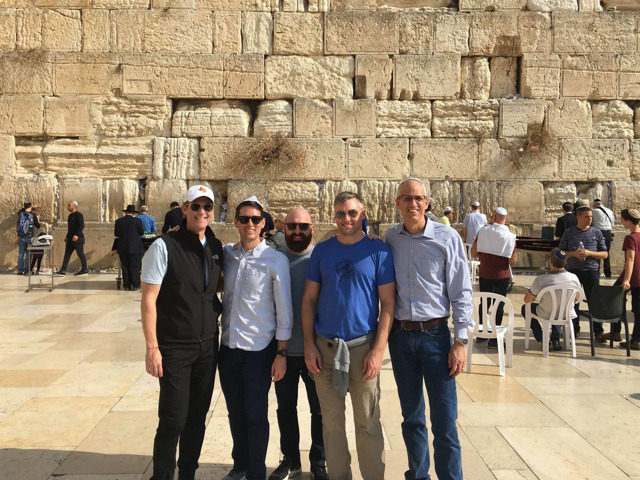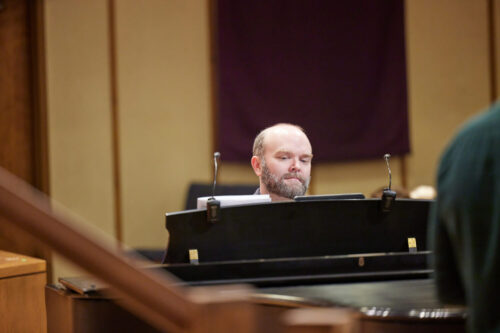Seeing The Holy Land
Five men from Covenant traveled to Jerusalem at the beginning of December. Each walked away with a new understanding of life in the area. The “Israel” of the Middle East did not match the Israel we read about in the Bible, they agreed.
Watch this video for a brief history of Isreal.
The Trip’s Purpose
Covenant member Dustin Johnson, the founder and president of Long View Equity, invited the group to join him on a due diligence trip. Dustin’s client, Holy Land Trust—a Palestinian non-profit organization based in Bethlehem—is converting a building it owns near the Church of the Nativity into a boutique hotel and restaurant. As part of its social impact fund, Long View Equity invests in non-governmental organizations and small to medium enterprises in less developed countries. Holy Land Trust, which aims to strengthen communities by solving problems with solutions based on social justice, compassion and love, fit into Long View’s portfolio.
“I saw the December trip to Israel as an opportunity to not only check the boxes for due diligence, but to bring people along who would want to know what life is like for modern Christians in Palestine,” Dustin said.
Dustin had traveled to Jerusalem with his family last summer. He and his wife, Amy, were impressed with Holy Land Trust but surprised that much of what they saw happening in the region did not match how it is portrayed by the media. “We thought we understood the situation the Palestinians lived in under Israeli occupation—until we went. I didn’t know there were more than 50,000 Christian Palestinians in the West Bank.”
Dustin continued: “Church-going folks in Texas probably don’t know the situation either. Most Christians in Texas don’t realize they have brothers and sisters in Christ.”
And so Dustin and four other men from the church traveled as part of a group of 12 to Jerusalem in early December. Doug Kilday, Jay Corder, Daniel Campbell and Jon Wasson all made their first trip to The Holy Land. Dustin explained his invitations: “We actually all work together in some capacity. Doug is an attorney that I’ve know personally through Covenant. He’s done some work for us in the past, and he would bring an expertise in the law. When it comes time to work on agreements, he could alert us to things to think about.
“Daniel works for a real estate company here and does development work. His insights are very helpful. Jay is an architect. I don’t know how Jon got involved,” he joked.
Dustin’s company had a full agenda for the travelers. In addition to seeing the holy sites, the team spent time with a pastor who explained that Palestinian Christians feel abandoned by Christians in the U.S. “It’s very unfortunate, but a lot of the harsher elements of Israeli policy are enabled ultimately by conservative Christians in places like Texas,” Dustin said. “This stems from a misinterpretation of the Bible by fundamentalist preachers in churches here linking promises to Abraham about the land with the modern nation state of Israel and in the process, totally disregarding the plight of Palestinian brothers and sisters who are on the land and have been forever. From this pastor’s perspective, the message that gets communicated to them is that ‘we think you are part of the problem. We think that you need to get out of here. God gave this land to Israel.’ They feel like they have no one standing with them.”
“It’s very complicated,” Doug said. “Every person we talked to has a story. Jews were the victims of horrific oppression and misuse of power on the grandest scale imaginable in the 20th century. It seems like an injustice was done to correct that injustice and 700,000 Palestinian people were pushed out of their homes and 531 towns and villages were completely destroyed to make way for the nation state of Israel. What happened to the Palestinians is that they are still suffering and still devastated. Many still have keys to their homes and want to go back.
“To be clear,” Doug continued, “we are not choosing sides. It’s not like our media says: ‘Israel is good and Palestine is bad.’ In fact it’s the other way. It’s that we all suffer from the same human condition: we all are sinful. When too much power is placed in too few hands, history has always shown that it tends to get abused. That’s happening in the Holy Land: the people with the power are the Israelis and the people who are oppressed are the Palestinians. That’s not because Israel is bad the Palestinians are good; it’s just that the power dynamic is out of sync.”
Daniel walked away from the trip with a new understanding. “I fully anticipated going and seeing the spiritual side of Jerusalem and Canaan and all the places we got to visit. I was not expecting to see the realization of the Christians who live there and the context under which they live. The veil came off of understanding what Palestinians go through on a day-to-day basis.
“They are the definition of an oppressed people. They live under military law. They have daily necessities that are restricted, like access to water, access to reliable trash service, even things like access to infrastructure. There are certain roads that only Israelis can drive on,” Daniel said. “This wasn’t a conflict between Jewish people and Arabs; it’s really a conflict between oppressor and oppressed.”
Doug said that he was looking forward to seeing where Jesus walked, but he got much more. “The real surprise was that we also felt like we go to walk where Jesus was walking today, because He has always been with the oppressed, with the outcasts. We got to see His hands and feet at work through some of these peacemakers that we encountered.”
Jon added, “There’s the rich geography, the history, the archeology, but there’s also the very complicated geopolitics that all of us understand differently now—seeing the wall and the security checkpoints, and going through them ourselves with American passports,” Jon said.
“There’s also a tourism machine there that messes with your own spiritual pilgrimage,” Jon continued. “Cell phones have changed the way people interact with places. We were at the bottom of the Church of the Nativity, the place where Jesus was supposedly lain, and people are taking selfies.

“I was surprised that those sites didn’t mean as much to me as the people we met,” Jon said. “That’s where we encountered Jesus.”
Jay agreed, “I’m glad you said that. I walked away from a couple of places wondering why I wasn’t more moved.”
Jon continued. “Many times we think of Christian mission as going to evangelize or going to people who are not Christian. It is just as legitimate of a definition of Christian mission to go and minister to other Christians living in other places, to pray with them, to worship together, to pray for them, to learn from them about what is going on in their lives, to listen to them, to let them challenge us — that happened a lot. In that sense, it was a trip filled with mission and ministry,” he said.
Dan said, “Part of the mission was understanding the greater context of oppressed and oppressor, and once you see an oppressed people, it serves as an example that you can start applying to others. For me, I felt a different connection not just with the Palestinian cause but with other oppressed people.”
The group also drove to Nazareth and met with a group of Palestinian Baptists, one of the largest denominations in Palestine. There, the group saw Israeli citizens who are Palestinian Christians in Nazareth. “Life for them is much more normal,” Doug said. “They face discrimination but they are full Israeli citizens, so the freedom allowed to them is much better than the Palestinians in the West Bank.”
The group met a Muslim man who runs a non-profit organization within Aida, a large refugee camp; an Israeli settler in Hebron, the largest city in the West Bank; and an Israeli woman from England who is an activist supporting the Palestinians. “We had lots of different encounters with lots of different people. We had a taste of these issues from many different perspectives,” Jay said.
“One of the main reasons for the nonprofit within Aida was to give young people ways to resist and express their resistance in non-criminal ways,” Jon said. “So, not throwing rocks, but doing art, theater, music, photography and radio. [The nonprofit organizations] want to give them a way to process that anger in ways that they won’t be targeted by the Israeli military.”
Seeing God
The group was awed by their experience—not only by their new understanding of the plight of Palestinian Christians, but also by the region and the sites. “One morning we got up early and got access to the Temple Mount,” Dan recalled. “To be up there early without the large number of tourists, it was very quiet still. Standing there in the early morning hour, you could look over and see the Garden of Gethsemane and the Mount of Olives. That was a rich spiritual experience.”

Jon added, “The Sea of Galilee was pretty cool. All the other sites had been built upon and ruined over time. This was untouched. I could imagine the lakeshore; I could imagine Jesus. To me, that felt raw.”

Dustin said the early morning walks in Jerusalem were his personal highlight. “One of the guys with us had been to Jerusalem 14 times. He’s also a walker and he’d be in the lobby at 6 every morning.”
Every day, at least 10 men went on a morning walk. The first day, they went to the Church of the Holy Sepulchre and the door was open. Instead of the hordes of tourists that would be there later, they had the church to themselves. “We got to walk through the Muslim quarter and many different parts of the city as it was waking up. That was really neat,” Dustin said.
What Now?
The men are back in Austin and digesting what they learned in the Holy Land. “We need to simply share about our trip and the people we met that live in the West Bank. I would love it if more people at Covenant and other churches wanted to go take similar trips,” Dustin said.
“I had no idea of what I was going to see and experience,” Daniel said. “My biggest takeaway was the issue of basic human rights. It’s not Muslim, it’s not Christian, it’s not Jewish. It’s basic human rights. If you took the names out of it and put other nationalities and saw how [Palestinians] were being treated, it would be immediately obvious that they are not being treated like they should.”
Doug, who spent a year working in Cambodia, said the two experiences were different in that he was totally immersed in Cambodia, but they did have some similarities. “In both places, I got a glimpse of something that is beautiful and tragic all at the same time. It’s heartbreaking, and you feel like you’re in the presence of something holy. They were very comparable in that respect.”
Jon asked for prayers. “They invited prayer. That’s not the least we can do, that’s really something we can do—to pray with our brothers and sisters in Christ for God to act, to liberate, to bring peace, to reconcile.
“Education is also a big part of this. As a pastor, I can educate people to read the Bible differently so that when they read the word Israel they don’t think of a nation state established in 1948. That’s something different.”
The men will continue to learn about the area and invite all to join them. The Holy Land Book Club will be in FE 105 at 6:30 p.m. starting Wednesday, Jan. 16. Book club members will read “Jesus and the Land” by Gary Burge. Purchase a book and/or RSVP to Kathryn Sedberry.





